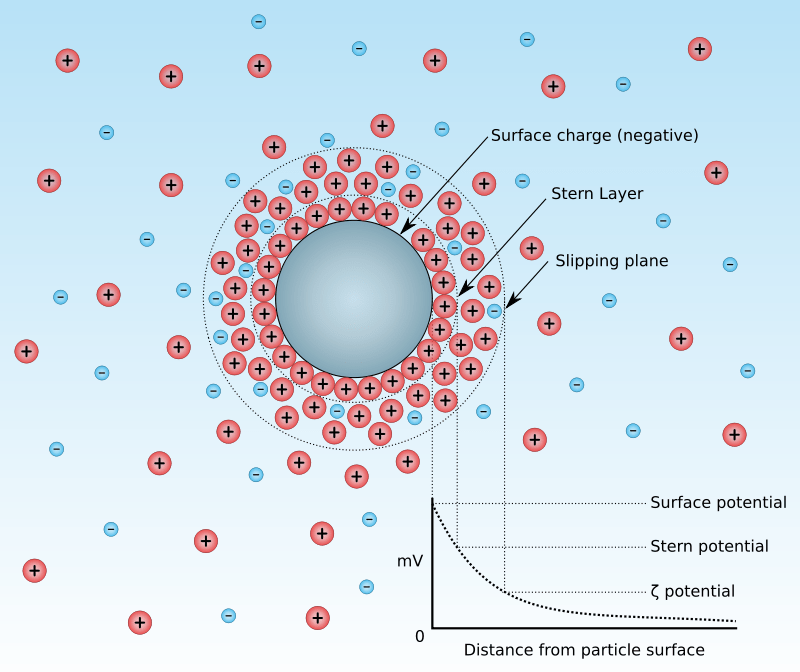The key difference between Nernst potential and Zeta potential is that Nernst potential is given for a biological cell or an electrochemical cell whereas zeta potential is given for a colloidal dispersion.
Nernst potential and zeta potential are terms in physical chemistry that describe the potential difference between something, e.g. the cell membrane, electrochemical cell, membrane of a dispersed particle in a dispersion medium, etc.
CONTENTS
1. Overview and Key Difference
2. What is Nernst Potential
3. What is Zeta Potential
4. Side by Side Comparison – Nernst Potential vs Zeta Potential in Tabular Form
5. Summary
What is Nernst Potential?
Nernst potential or reversal potential is the potential across a cell membrane that opposes the net diffusion of a particular ion through the membrane. Therefore, this term has applications in biochemistry. We can determine the Nernst potential by the ratio of the concentrations of that specific ion (which is trying to pass through the cell membrane) inside the cell and outside the cell. However, this term is also used in electrochemistry, regarding electrochemical cells. The equation which is used to determine the Nernst potential is called the Nernst equation.
Nernst equation can be described as a mathematical expression that gives the relationship between reduction potential and the standard reduction potential of an electrochemical cell. This equation was named after the scientist Walther Nernst. Furthermore, this equation was developed using the other factors affecting electrochemical oxidation and reduction reactions, such as temperature and chemical activity of chemical species that undergo oxidation and reduction.
To obtain the Nernst equation, we have to consider the standard changes in Gibbs free energy that is associated with electrochemical transformations that occur in the cell. The reduction reaction of an electrochemical cell can be given as follows:
Ox + z e– ⟶ Red
In thermodynamics, the actual free energy change of the reaction is,
E = Ereduction – Eoxidation
We can relate the Gibbs free energy(ΔG) to the E (potential difference) as follows:
ΔG = -nFE
Where n is the number of electrons transferred between chemical species when the reaction is progressing, F is the Faraday constant. If we consider the standard conditions, then the equation is as follows:
ΔG0 = -nFE0
We can relate Gibbs free energy of non-standard conditions with the Gibbs energy of standard conditions via the following equation.
ΔG = ΔG0 + RTlnQ
Then, we can substitute the above equations into this standard equation to get the Nernst equation as follows:
-nFE = -nFE0 + RTlnQ
Then the Nernst equation is as follows:
E = E0 – (RTlnQ/nF)
What is Zeta Potential?
Zeta potential is the electrokinetic potential of a colloidal dispersion. This term comes from the Greek letter “zeta”. Generally, we call this electrokinetic potential zeta potential. In other words, zeta potential is the potential difference between the dispersion medium and the stationary layer of the fluid attached to the dispersed particle of the colloidal dispersion. That means the term zeta potential gives us an indication of the charge that is present on the particle surface. We can recognize two types of zeta potential: positive and negative zeta potential. Further, this potential is what we measure as the velocity of the particles in a d.c. electric field.

Figure 01: A Particle in a Colloidal Suspension
Among the two types, the positive zeta potential indicates that the dispersed particles in the suspension in which we measure the zeta potential have a positive charge. Moreover, when we are considering the values, there is no significant difference between positive and negative zeta potential.
On the other hand, negative zeta potential indicates that the dispersed particles in the suspension in which we measure the zeta potential have a negative charge; thus, the charge of the dispersed particles is negative.
What is the Difference Between Nernst Potential and Zeta Potential?
Nernst potential and zeta potential are used in physical chemistry. The key difference between Nernst potential and Zeta potential is that Nernst potential is given for a biological cell or an electrochemical cell whereas zeta potential is given for a colloidal dispersion.
Below infographic shows more differences between Nernst potential and Zeta potential.

Summary – Nernst Potential vs Zeta Potential
The terms Nernst potential and zeta potential are used in physical chemistry. The key difference between Nernst potential and Zeta potential is that Nernst potential is given for a biological cell or an electrochemical cell whereas zeta potential is given for a colloidal dispersion.
Reference:
1. “Zeta Potential.” Wikipedia. 23 June 2020, Available here.
Image Courtesy:
1. “Diagram of zeta potential and slipping planeV2” By Modified and converted to SVG by Mjones1984. Original work by Larryisgood. –(CC BY-SA 3.0) via Commons Wikimedia
ncG1vNJzZmivp6x7pbXFn5yrnZ6YsqOx07CcnqZemLyue8OinZ%2Bdopq7pLGMm5ytr5Wau266xKulrKxdpby1sc2toJqkXZa7pXnZnquaZaCkwaa606KYpWc%3D